Uber's Stakeholders: An Analysis of Corporate Social Responsibility
VerifiedAdded on 2023/01/23
|13
|3838
|29
Report
AI Summary
This report provides a stakeholder analysis of Uber, examining the company through the lens of Stakeholder Theory. It investigates Uber's interactions with various stakeholder groups, including employees (drivers), customers, shareholders, and communities of interest, focusing on their respective interests and the ethical considerations involved. The analysis delves into areas such as expenses, earnings, decision-making, and evaluation within the context of the gig economy. The report also explores corporate social responsibility (CSR) issues related to each stakeholder group, such as concerns about driver safety, customer experiences, and shareholder profitability. The report highlights the challenges Uber faces in balancing the interests of its diverse stakeholders and addresses issues such as sexual harassment, employee treatment, and community impact. This analysis aims to provide a comprehensive understanding of Uber's stakeholder relationships and its approach to ethical business practices in the ride-sharing industry.
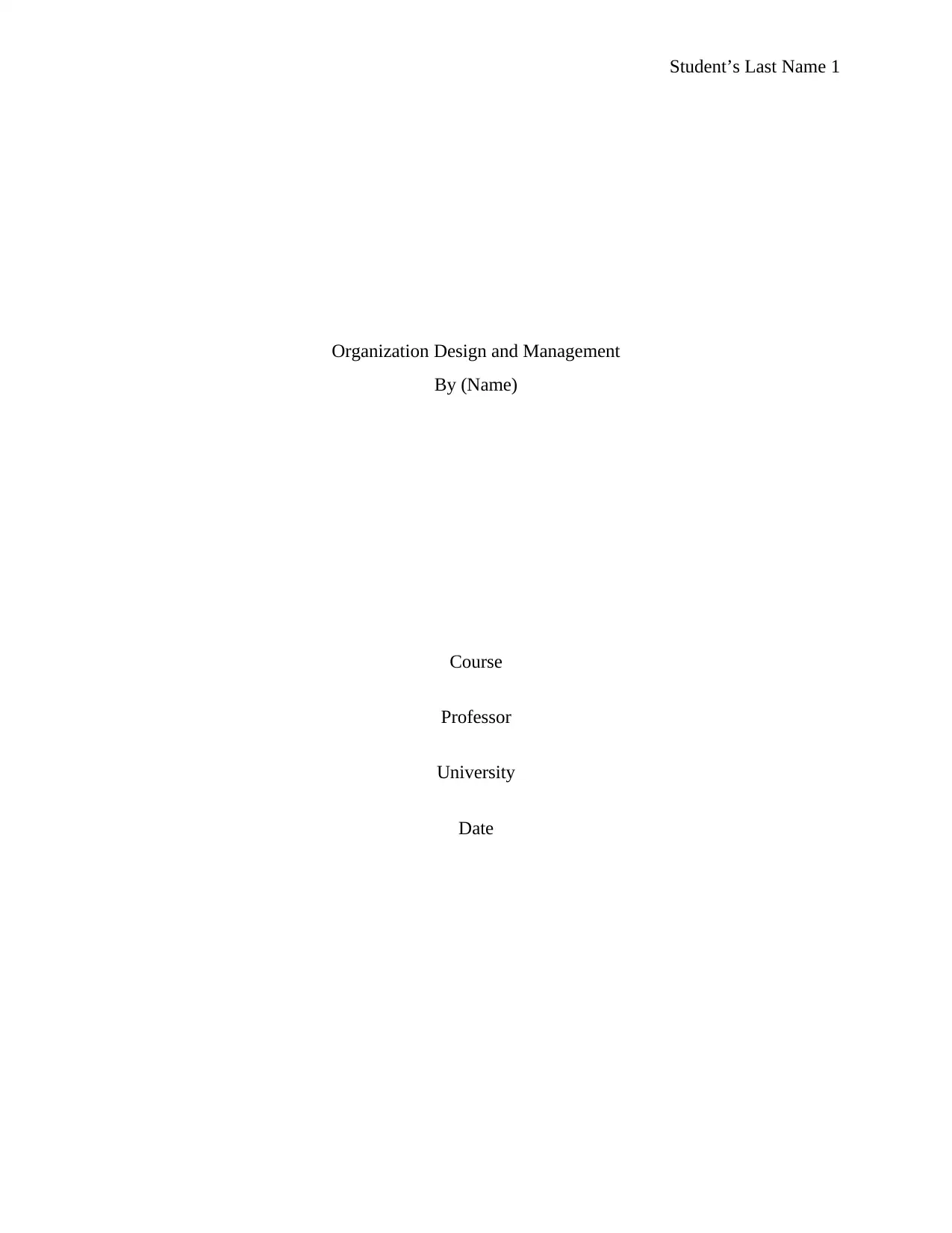
Student’s Last Name 1
Organization Design and Management
By (Name)
Course
Professor
University
Date
Organization Design and Management
By (Name)
Course
Professor
University
Date
Paraphrase This Document
Need a fresh take? Get an instant paraphrase of this document with our AI Paraphraser
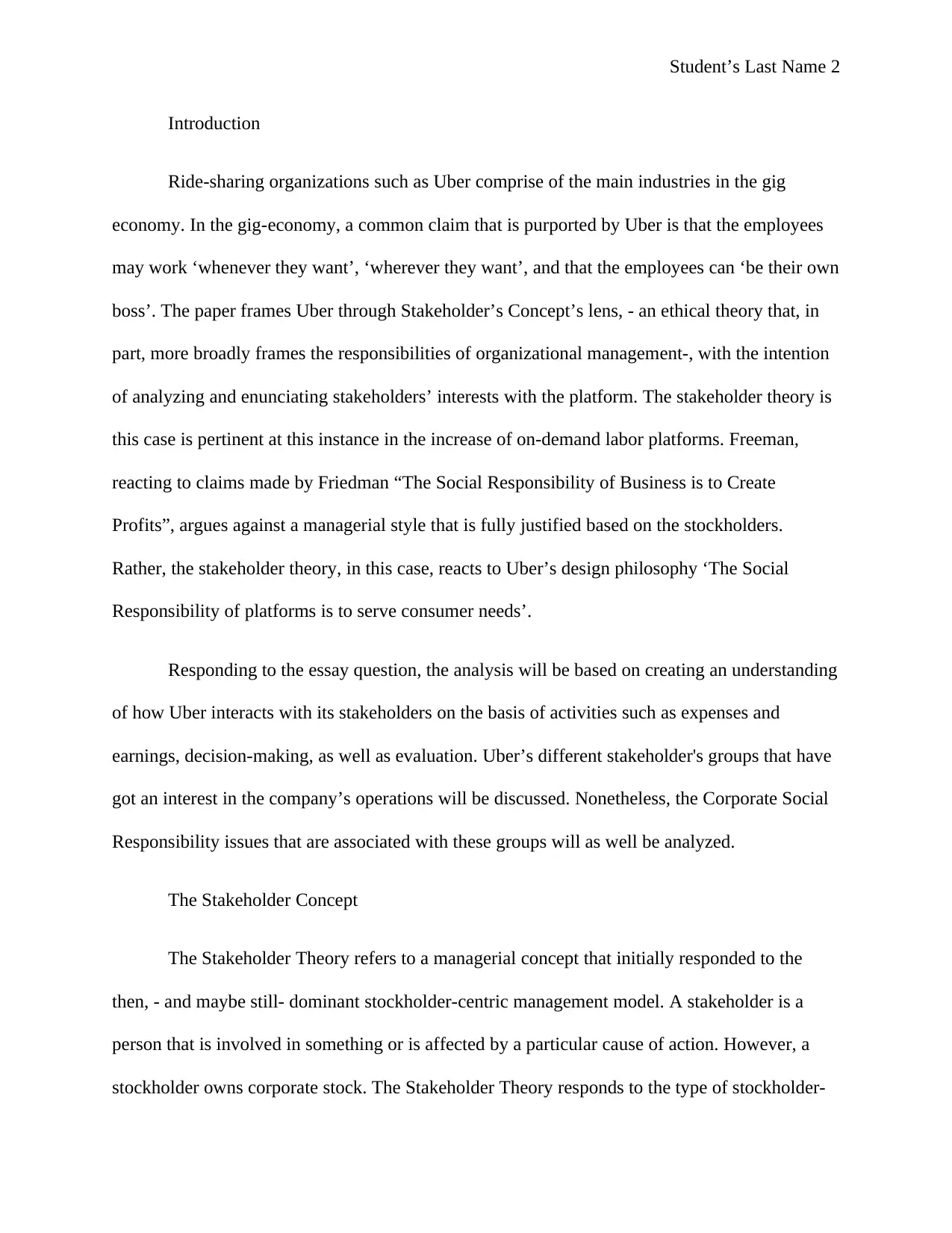
Student’s Last Name 2
Introduction
Ride-sharing organizations such as Uber comprise of the main industries in the gig
economy. In the gig-economy, a common claim that is purported by Uber is that the employees
may work ‘whenever they want’, ‘wherever they want’, and that the employees can ‘be their own
boss’. The paper frames Uber through Stakeholder’s Concept’s lens, - an ethical theory that, in
part, more broadly frames the responsibilities of organizational management-, with the intention
of analyzing and enunciating stakeholders’ interests with the platform. The stakeholder theory is
this case is pertinent at this instance in the increase of on-demand labor platforms. Freeman,
reacting to claims made by Friedman “The Social Responsibility of Business is to Create
Profits”, argues against a managerial style that is fully justified based on the stockholders.
Rather, the stakeholder theory, in this case, reacts to Uber’s design philosophy ‘The Social
Responsibility of platforms is to serve consumer needs’.
Responding to the essay question, the analysis will be based on creating an understanding
of how Uber interacts with its stakeholders on the basis of activities such as expenses and
earnings, decision-making, as well as evaluation. Uber’s different stakeholder's groups that have
got an interest in the company’s operations will be discussed. Nonetheless, the Corporate Social
Responsibility issues that are associated with these groups will as well be analyzed.
The Stakeholder Concept
The Stakeholder Theory refers to a managerial concept that initially responded to the
then, - and maybe still- dominant stockholder-centric management model. A stakeholder is a
person that is involved in something or is affected by a particular cause of action. However, a
stockholder owns corporate stock. The Stakeholder Theory responds to the type of stockholder-
Introduction
Ride-sharing organizations such as Uber comprise of the main industries in the gig
economy. In the gig-economy, a common claim that is purported by Uber is that the employees
may work ‘whenever they want’, ‘wherever they want’, and that the employees can ‘be their own
boss’. The paper frames Uber through Stakeholder’s Concept’s lens, - an ethical theory that, in
part, more broadly frames the responsibilities of organizational management-, with the intention
of analyzing and enunciating stakeholders’ interests with the platform. The stakeholder theory is
this case is pertinent at this instance in the increase of on-demand labor platforms. Freeman,
reacting to claims made by Friedman “The Social Responsibility of Business is to Create
Profits”, argues against a managerial style that is fully justified based on the stockholders.
Rather, the stakeholder theory, in this case, reacts to Uber’s design philosophy ‘The Social
Responsibility of platforms is to serve consumer needs’.
Responding to the essay question, the analysis will be based on creating an understanding
of how Uber interacts with its stakeholders on the basis of activities such as expenses and
earnings, decision-making, as well as evaluation. Uber’s different stakeholder's groups that have
got an interest in the company’s operations will be discussed. Nonetheless, the Corporate Social
Responsibility issues that are associated with these groups will as well be analyzed.
The Stakeholder Concept
The Stakeholder Theory refers to a managerial concept that initially responded to the
then, - and maybe still- dominant stockholder-centric management model. A stakeholder is a
person that is involved in something or is affected by a particular cause of action. However, a
stockholder owns corporate stock. The Stakeholder Theory responds to the type of stockholder-
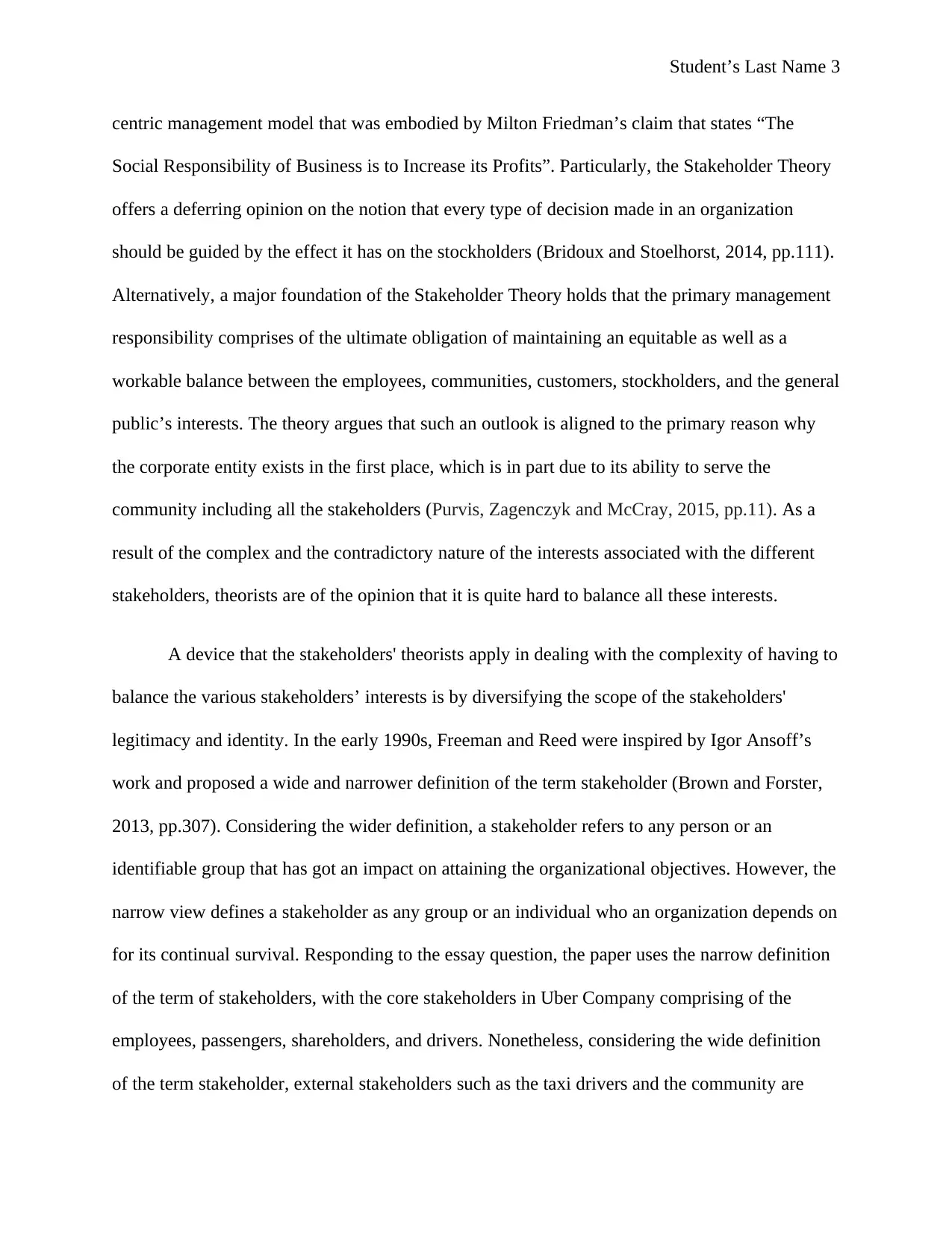
Student’s Last Name 3
centric management model that was embodied by Milton Friedman’s claim that states “The
Social Responsibility of Business is to Increase its Profits”. Particularly, the Stakeholder Theory
offers a deferring opinion on the notion that every type of decision made in an organization
should be guided by the effect it has on the stockholders (Bridoux and Stoelhorst, 2014, pp.111).
Alternatively, a major foundation of the Stakeholder Theory holds that the primary management
responsibility comprises of the ultimate obligation of maintaining an equitable as well as a
workable balance between the employees, communities, customers, stockholders, and the general
public’s interests. The theory argues that such an outlook is aligned to the primary reason why
the corporate entity exists in the first place, which is in part due to its ability to serve the
community including all the stakeholders (Purvis, Zagenczyk and McCray, 2015, pp.11). As a
result of the complex and the contradictory nature of the interests associated with the different
stakeholders, theorists are of the opinion that it is quite hard to balance all these interests.
A device that the stakeholders' theorists apply in dealing with the complexity of having to
balance the various stakeholders’ interests is by diversifying the scope of the stakeholders'
legitimacy and identity. In the early 1990s, Freeman and Reed were inspired by Igor Ansoff’s
work and proposed a wide and narrower definition of the term stakeholder (Brown and Forster,
2013, pp.307). Considering the wider definition, a stakeholder refers to any person or an
identifiable group that has got an impact on attaining the organizational objectives. However, the
narrow view defines a stakeholder as any group or an individual who an organization depends on
for its continual survival. Responding to the essay question, the paper uses the narrow definition
of the term of stakeholders, with the core stakeholders in Uber Company comprising of the
employees, passengers, shareholders, and drivers. Nonetheless, considering the wide definition
of the term stakeholder, external stakeholders such as the taxi drivers and the community are
centric management model that was embodied by Milton Friedman’s claim that states “The
Social Responsibility of Business is to Increase its Profits”. Particularly, the Stakeholder Theory
offers a deferring opinion on the notion that every type of decision made in an organization
should be guided by the effect it has on the stockholders (Bridoux and Stoelhorst, 2014, pp.111).
Alternatively, a major foundation of the Stakeholder Theory holds that the primary management
responsibility comprises of the ultimate obligation of maintaining an equitable as well as a
workable balance between the employees, communities, customers, stockholders, and the general
public’s interests. The theory argues that such an outlook is aligned to the primary reason why
the corporate entity exists in the first place, which is in part due to its ability to serve the
community including all the stakeholders (Purvis, Zagenczyk and McCray, 2015, pp.11). As a
result of the complex and the contradictory nature of the interests associated with the different
stakeholders, theorists are of the opinion that it is quite hard to balance all these interests.
A device that the stakeholders' theorists apply in dealing with the complexity of having to
balance the various stakeholders’ interests is by diversifying the scope of the stakeholders'
legitimacy and identity. In the early 1990s, Freeman and Reed were inspired by Igor Ansoff’s
work and proposed a wide and narrower definition of the term stakeholder (Brown and Forster,
2013, pp.307). Considering the wider definition, a stakeholder refers to any person or an
identifiable group that has got an impact on attaining the organizational objectives. However, the
narrow view defines a stakeholder as any group or an individual who an organization depends on
for its continual survival. Responding to the essay question, the paper uses the narrow definition
of the term of stakeholders, with the core stakeholders in Uber Company comprising of the
employees, passengers, shareholders, and drivers. Nonetheless, considering the wide definition
of the term stakeholder, external stakeholders such as the taxi drivers and the community are
⊘ This is a preview!⊘
Do you want full access?
Subscribe today to unlock all pages.

Trusted by 1+ million students worldwide
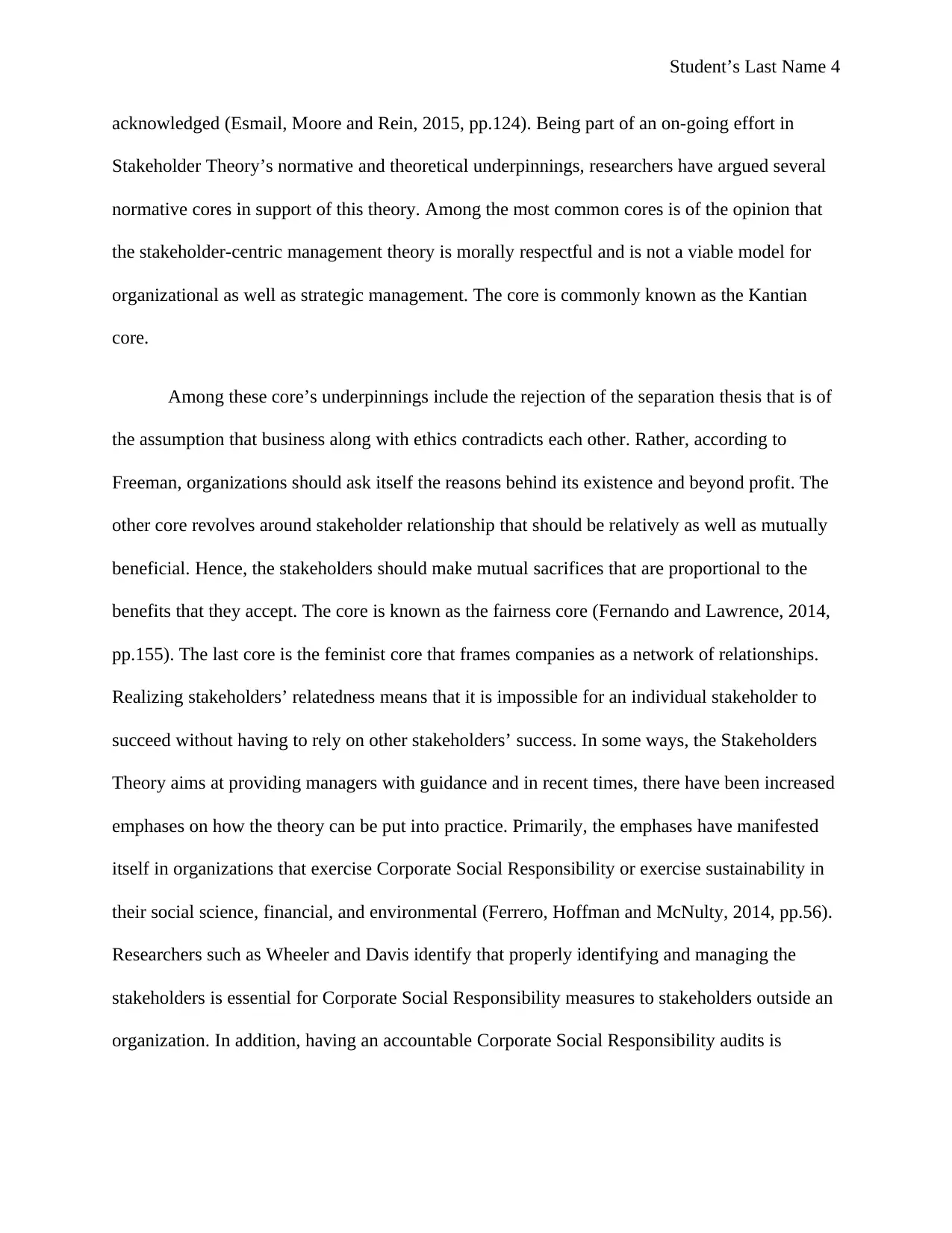
Student’s Last Name 4
acknowledged (Esmail, Moore and Rein, 2015, pp.124). Being part of an on-going effort in
Stakeholder Theory’s normative and theoretical underpinnings, researchers have argued several
normative cores in support of this theory. Among the most common cores is of the opinion that
the stakeholder-centric management theory is morally respectful and is not a viable model for
organizational as well as strategic management. The core is commonly known as the Kantian
core.
Among these core’s underpinnings include the rejection of the separation thesis that is of
the assumption that business along with ethics contradicts each other. Rather, according to
Freeman, organizations should ask itself the reasons behind its existence and beyond profit. The
other core revolves around stakeholder relationship that should be relatively as well as mutually
beneficial. Hence, the stakeholders should make mutual sacrifices that are proportional to the
benefits that they accept. The core is known as the fairness core (Fernando and Lawrence, 2014,
pp.155). The last core is the feminist core that frames companies as a network of relationships.
Realizing stakeholders’ relatedness means that it is impossible for an individual stakeholder to
succeed without having to rely on other stakeholders’ success. In some ways, the Stakeholders
Theory aims at providing managers with guidance and in recent times, there have been increased
emphases on how the theory can be put into practice. Primarily, the emphases have manifested
itself in organizations that exercise Corporate Social Responsibility or exercise sustainability in
their social science, financial, and environmental (Ferrero, Hoffman and McNulty, 2014, pp.56).
Researchers such as Wheeler and Davis identify that properly identifying and managing the
stakeholders is essential for Corporate Social Responsibility measures to stakeholders outside an
organization. In addition, having an accountable Corporate Social Responsibility audits is
acknowledged (Esmail, Moore and Rein, 2015, pp.124). Being part of an on-going effort in
Stakeholder Theory’s normative and theoretical underpinnings, researchers have argued several
normative cores in support of this theory. Among the most common cores is of the opinion that
the stakeholder-centric management theory is morally respectful and is not a viable model for
organizational as well as strategic management. The core is commonly known as the Kantian
core.
Among these core’s underpinnings include the rejection of the separation thesis that is of
the assumption that business along with ethics contradicts each other. Rather, according to
Freeman, organizations should ask itself the reasons behind its existence and beyond profit. The
other core revolves around stakeholder relationship that should be relatively as well as mutually
beneficial. Hence, the stakeholders should make mutual sacrifices that are proportional to the
benefits that they accept. The core is known as the fairness core (Fernando and Lawrence, 2014,
pp.155). The last core is the feminist core that frames companies as a network of relationships.
Realizing stakeholders’ relatedness means that it is impossible for an individual stakeholder to
succeed without having to rely on other stakeholders’ success. In some ways, the Stakeholders
Theory aims at providing managers with guidance and in recent times, there have been increased
emphases on how the theory can be put into practice. Primarily, the emphases have manifested
itself in organizations that exercise Corporate Social Responsibility or exercise sustainability in
their social science, financial, and environmental (Ferrero, Hoffman and McNulty, 2014, pp.56).
Researchers such as Wheeler and Davis identify that properly identifying and managing the
stakeholders is essential for Corporate Social Responsibility measures to stakeholders outside an
organization. In addition, having an accountable Corporate Social Responsibility audits is
Paraphrase This Document
Need a fresh take? Get an instant paraphrase of this document with our AI Paraphraser
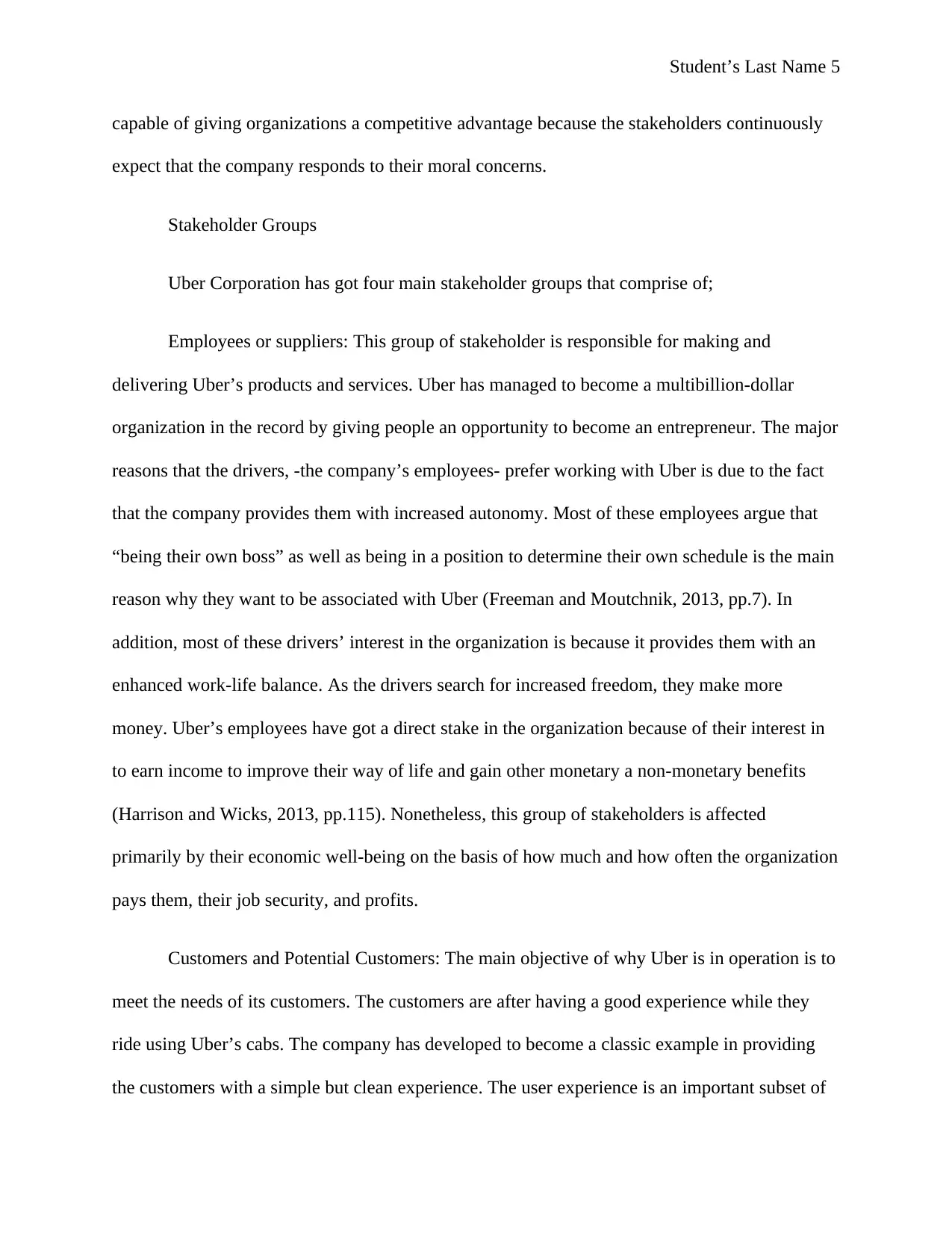
Student’s Last Name 5
capable of giving organizations a competitive advantage because the stakeholders continuously
expect that the company responds to their moral concerns.
Stakeholder Groups
Uber Corporation has got four main stakeholder groups that comprise of;
Employees or suppliers: This group of stakeholder is responsible for making and
delivering Uber’s products and services. Uber has managed to become a multibillion-dollar
organization in the record by giving people an opportunity to become an entrepreneur. The major
reasons that the drivers, -the company’s employees- prefer working with Uber is due to the fact
that the company provides them with increased autonomy. Most of these employees argue that
“being their own boss” as well as being in a position to determine their own schedule is the main
reason why they want to be associated with Uber (Freeman and Moutchnik, 2013, pp.7). In
addition, most of these drivers’ interest in the organization is because it provides them with an
enhanced work-life balance. As the drivers search for increased freedom, they make more
money. Uber’s employees have got a direct stake in the organization because of their interest in
to earn income to improve their way of life and gain other monetary a non-monetary benefits
(Harrison and Wicks, 2013, pp.115). Nonetheless, this group of stakeholders is affected
primarily by their economic well-being on the basis of how much and how often the organization
pays them, their job security, and profits.
Customers and Potential Customers: The main objective of why Uber is in operation is to
meet the needs of its customers. The customers are after having a good experience while they
ride using Uber’s cabs. The company has developed to become a classic example in providing
the customers with a simple but clean experience. The user experience is an important subset of
capable of giving organizations a competitive advantage because the stakeholders continuously
expect that the company responds to their moral concerns.
Stakeholder Groups
Uber Corporation has got four main stakeholder groups that comprise of;
Employees or suppliers: This group of stakeholder is responsible for making and
delivering Uber’s products and services. Uber has managed to become a multibillion-dollar
organization in the record by giving people an opportunity to become an entrepreneur. The major
reasons that the drivers, -the company’s employees- prefer working with Uber is due to the fact
that the company provides them with increased autonomy. Most of these employees argue that
“being their own boss” as well as being in a position to determine their own schedule is the main
reason why they want to be associated with Uber (Freeman and Moutchnik, 2013, pp.7). In
addition, most of these drivers’ interest in the organization is because it provides them with an
enhanced work-life balance. As the drivers search for increased freedom, they make more
money. Uber’s employees have got a direct stake in the organization because of their interest in
to earn income to improve their way of life and gain other monetary a non-monetary benefits
(Harrison and Wicks, 2013, pp.115). Nonetheless, this group of stakeholders is affected
primarily by their economic well-being on the basis of how much and how often the organization
pays them, their job security, and profits.
Customers and Potential Customers: The main objective of why Uber is in operation is to
meet the needs of its customers. The customers are after having a good experience while they
ride using Uber’s cabs. The company has developed to become a classic example in providing
the customers with a simple but clean experience. The user experience is an important subset of
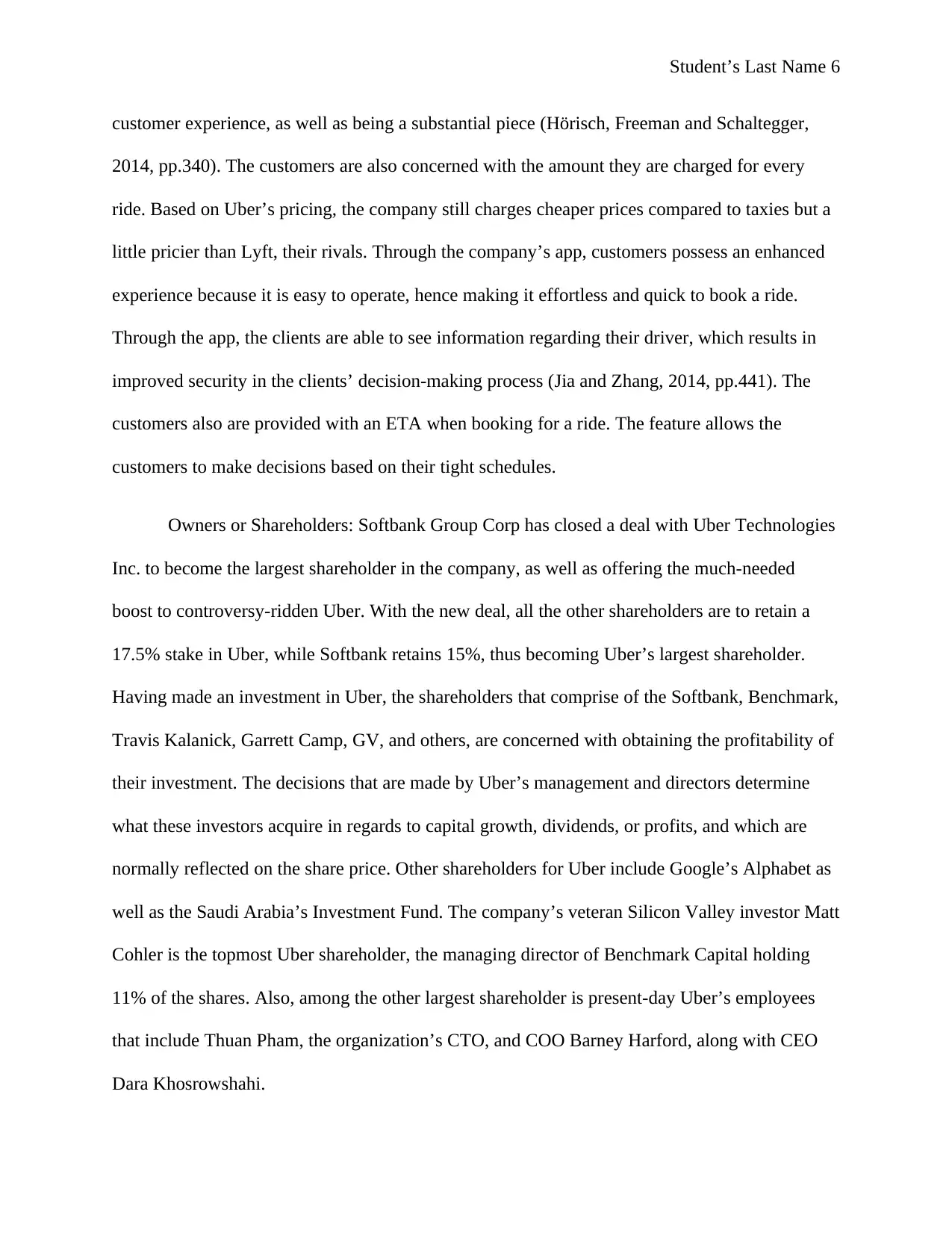
Student’s Last Name 6
customer experience, as well as being a substantial piece (Hörisch, Freeman and Schaltegger,
2014, pp.340). The customers are also concerned with the amount they are charged for every
ride. Based on Uber’s pricing, the company still charges cheaper prices compared to taxies but a
little pricier than Lyft, their rivals. Through the company’s app, customers possess an enhanced
experience because it is easy to operate, hence making it effortless and quick to book a ride.
Through the app, the clients are able to see information regarding their driver, which results in
improved security in the clients’ decision-making process (Jia and Zhang, 2014, pp.441). The
customers also are provided with an ETA when booking for a ride. The feature allows the
customers to make decisions based on their tight schedules.
Owners or Shareholders: Softbank Group Corp has closed a deal with Uber Technologies
Inc. to become the largest shareholder in the company, as well as offering the much-needed
boost to controversy-ridden Uber. With the new deal, all the other shareholders are to retain a
17.5% stake in Uber, while Softbank retains 15%, thus becoming Uber’s largest shareholder.
Having made an investment in Uber, the shareholders that comprise of the Softbank, Benchmark,
Travis Kalanick, Garrett Camp, GV, and others, are concerned with obtaining the profitability of
their investment. The decisions that are made by Uber’s management and directors determine
what these investors acquire in regards to capital growth, dividends, or profits, and which are
normally reflected on the share price. Other shareholders for Uber include Google’s Alphabet as
well as the Saudi Arabia’s Investment Fund. The company’s veteran Silicon Valley investor Matt
Cohler is the topmost Uber shareholder, the managing director of Benchmark Capital holding
11% of the shares. Also, among the other largest shareholder is present-day Uber’s employees
that include Thuan Pham, the organization’s CTO, and COO Barney Harford, along with CEO
Dara Khosrowshahi.
customer experience, as well as being a substantial piece (Hörisch, Freeman and Schaltegger,
2014, pp.340). The customers are also concerned with the amount they are charged for every
ride. Based on Uber’s pricing, the company still charges cheaper prices compared to taxies but a
little pricier than Lyft, their rivals. Through the company’s app, customers possess an enhanced
experience because it is easy to operate, hence making it effortless and quick to book a ride.
Through the app, the clients are able to see information regarding their driver, which results in
improved security in the clients’ decision-making process (Jia and Zhang, 2014, pp.441). The
customers also are provided with an ETA when booking for a ride. The feature allows the
customers to make decisions based on their tight schedules.
Owners or Shareholders: Softbank Group Corp has closed a deal with Uber Technologies
Inc. to become the largest shareholder in the company, as well as offering the much-needed
boost to controversy-ridden Uber. With the new deal, all the other shareholders are to retain a
17.5% stake in Uber, while Softbank retains 15%, thus becoming Uber’s largest shareholder.
Having made an investment in Uber, the shareholders that comprise of the Softbank, Benchmark,
Travis Kalanick, Garrett Camp, GV, and others, are concerned with obtaining the profitability of
their investment. The decisions that are made by Uber’s management and directors determine
what these investors acquire in regards to capital growth, dividends, or profits, and which are
normally reflected on the share price. Other shareholders for Uber include Google’s Alphabet as
well as the Saudi Arabia’s Investment Fund. The company’s veteran Silicon Valley investor Matt
Cohler is the topmost Uber shareholder, the managing director of Benchmark Capital holding
11% of the shares. Also, among the other largest shareholder is present-day Uber’s employees
that include Thuan Pham, the organization’s CTO, and COO Barney Harford, along with CEO
Dara Khosrowshahi.
⊘ This is a preview!⊘
Do you want full access?
Subscribe today to unlock all pages.

Trusted by 1+ million students worldwide
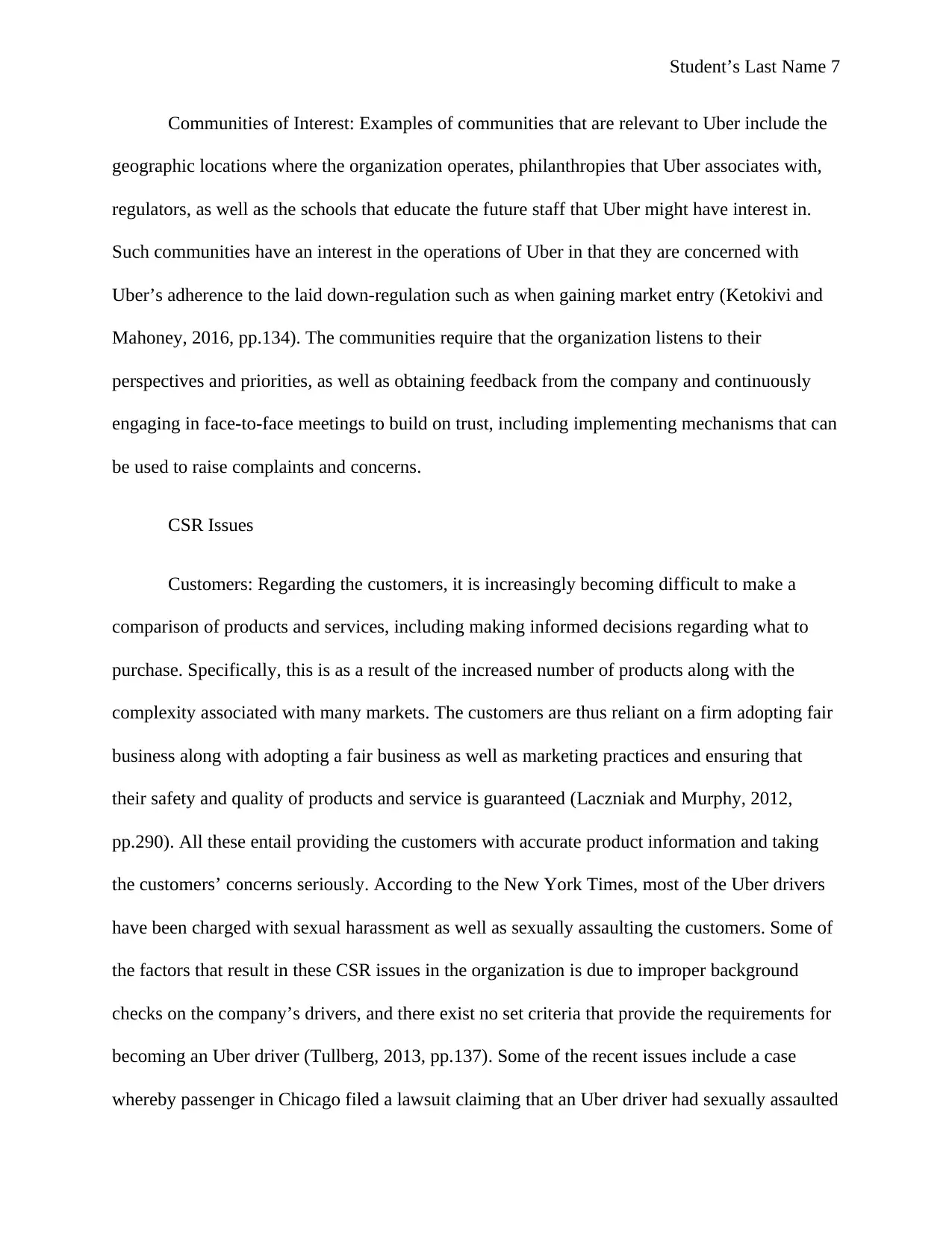
Student’s Last Name 7
Communities of Interest: Examples of communities that are relevant to Uber include the
geographic locations where the organization operates, philanthropies that Uber associates with,
regulators, as well as the schools that educate the future staff that Uber might have interest in.
Such communities have an interest in the operations of Uber in that they are concerned with
Uber’s adherence to the laid down-regulation such as when gaining market entry (Ketokivi and
Mahoney, 2016, pp.134). The communities require that the organization listens to their
perspectives and priorities, as well as obtaining feedback from the company and continuously
engaging in face-to-face meetings to build on trust, including implementing mechanisms that can
be used to raise complaints and concerns.
CSR Issues
Customers: Regarding the customers, it is increasingly becoming difficult to make a
comparison of products and services, including making informed decisions regarding what to
purchase. Specifically, this is as a result of the increased number of products along with the
complexity associated with many markets. The customers are thus reliant on a firm adopting fair
business along with adopting a fair business as well as marketing practices and ensuring that
their safety and quality of products and service is guaranteed (Laczniak and Murphy, 2012,
pp.290). All these entail providing the customers with accurate product information and taking
the customers’ concerns seriously. According to the New York Times, most of the Uber drivers
have been charged with sexual harassment as well as sexually assaulting the customers. Some of
the factors that result in these CSR issues in the organization is due to improper background
checks on the company’s drivers, and there exist no set criteria that provide the requirements for
becoming an Uber driver (Tullberg, 2013, pp.137). Some of the recent issues include a case
whereby passenger in Chicago filed a lawsuit claiming that an Uber driver had sexually assaulted
Communities of Interest: Examples of communities that are relevant to Uber include the
geographic locations where the organization operates, philanthropies that Uber associates with,
regulators, as well as the schools that educate the future staff that Uber might have interest in.
Such communities have an interest in the operations of Uber in that they are concerned with
Uber’s adherence to the laid down-regulation such as when gaining market entry (Ketokivi and
Mahoney, 2016, pp.134). The communities require that the organization listens to their
perspectives and priorities, as well as obtaining feedback from the company and continuously
engaging in face-to-face meetings to build on trust, including implementing mechanisms that can
be used to raise complaints and concerns.
CSR Issues
Customers: Regarding the customers, it is increasingly becoming difficult to make a
comparison of products and services, including making informed decisions regarding what to
purchase. Specifically, this is as a result of the increased number of products along with the
complexity associated with many markets. The customers are thus reliant on a firm adopting fair
business along with adopting a fair business as well as marketing practices and ensuring that
their safety and quality of products and service is guaranteed (Laczniak and Murphy, 2012,
pp.290). All these entail providing the customers with accurate product information and taking
the customers’ concerns seriously. According to the New York Times, most of the Uber drivers
have been charged with sexual harassment as well as sexually assaulting the customers. Some of
the factors that result in these CSR issues in the organization is due to improper background
checks on the company’s drivers, and there exist no set criteria that provide the requirements for
becoming an Uber driver (Tullberg, 2013, pp.137). Some of the recent issues include a case
whereby passenger in Chicago filed a lawsuit claiming that an Uber driver had sexually assaulted
Paraphrase This Document
Need a fresh take? Get an instant paraphrase of this document with our AI Paraphraser
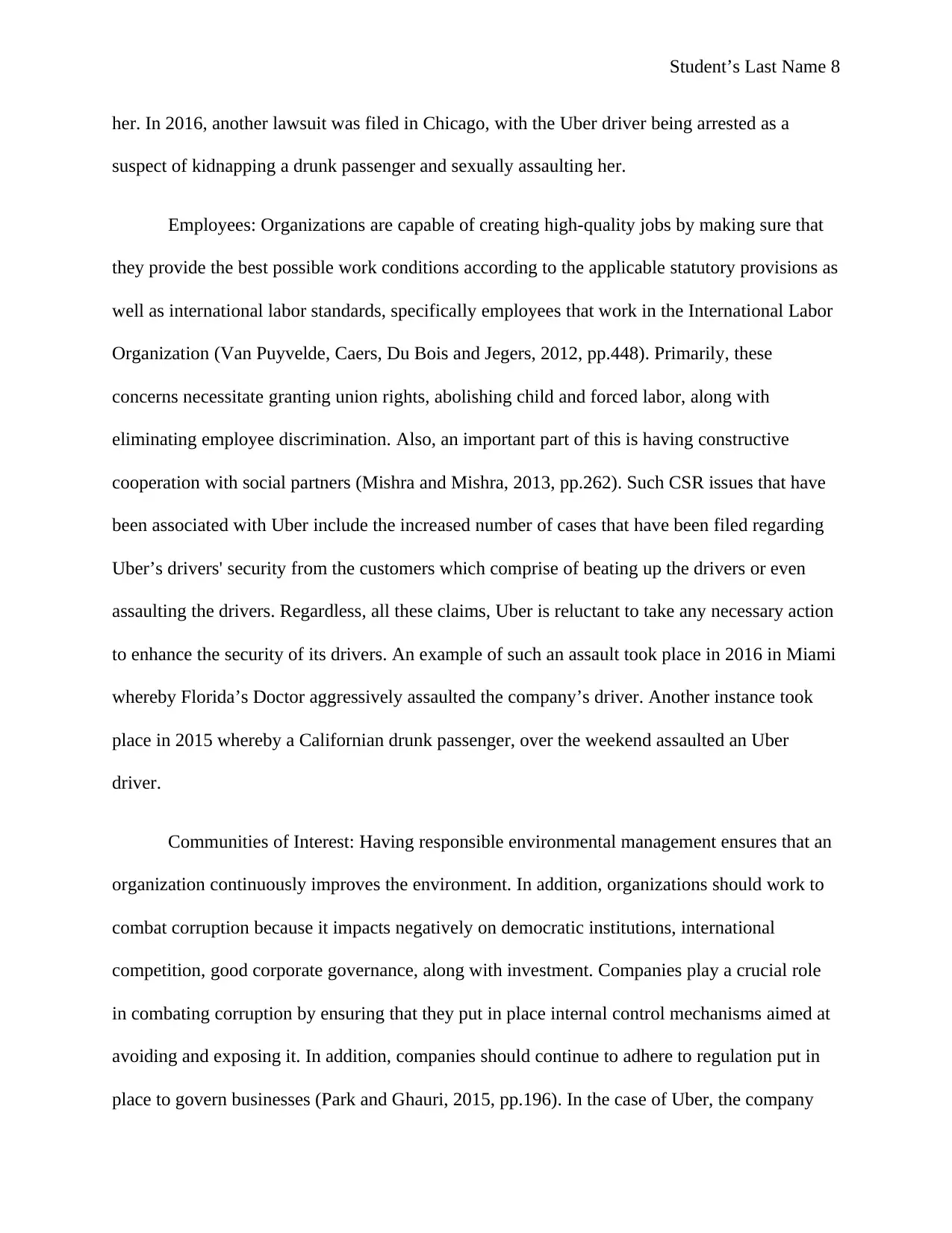
Student’s Last Name 8
her. In 2016, another lawsuit was filed in Chicago, with the Uber driver being arrested as a
suspect of kidnapping a drunk passenger and sexually assaulting her.
Employees: Organizations are capable of creating high-quality jobs by making sure that
they provide the best possible work conditions according to the applicable statutory provisions as
well as international labor standards, specifically employees that work in the International Labor
Organization (Van Puyvelde, Caers, Du Bois and Jegers, 2012, pp.448). Primarily, these
concerns necessitate granting union rights, abolishing child and forced labor, along with
eliminating employee discrimination. Also, an important part of this is having constructive
cooperation with social partners (Mishra and Mishra, 2013, pp.262). Such CSR issues that have
been associated with Uber include the increased number of cases that have been filed regarding
Uber’s drivers' security from the customers which comprise of beating up the drivers or even
assaulting the drivers. Regardless, all these claims, Uber is reluctant to take any necessary action
to enhance the security of its drivers. An example of such an assault took place in 2016 in Miami
whereby Florida’s Doctor aggressively assaulted the company’s driver. Another instance took
place in 2015 whereby a Californian drunk passenger, over the weekend assaulted an Uber
driver.
Communities of Interest: Having responsible environmental management ensures that an
organization continuously improves the environment. In addition, organizations should work to
combat corruption because it impacts negatively on democratic institutions, international
competition, good corporate governance, along with investment. Companies play a crucial role
in combating corruption by ensuring that they put in place internal control mechanisms aimed at
avoiding and exposing it. In addition, companies should continue to adhere to regulation put in
place to govern businesses (Park and Ghauri, 2015, pp.196). In the case of Uber, the company
her. In 2016, another lawsuit was filed in Chicago, with the Uber driver being arrested as a
suspect of kidnapping a drunk passenger and sexually assaulting her.
Employees: Organizations are capable of creating high-quality jobs by making sure that
they provide the best possible work conditions according to the applicable statutory provisions as
well as international labor standards, specifically employees that work in the International Labor
Organization (Van Puyvelde, Caers, Du Bois and Jegers, 2012, pp.448). Primarily, these
concerns necessitate granting union rights, abolishing child and forced labor, along with
eliminating employee discrimination. Also, an important part of this is having constructive
cooperation with social partners (Mishra and Mishra, 2013, pp.262). Such CSR issues that have
been associated with Uber include the increased number of cases that have been filed regarding
Uber’s drivers' security from the customers which comprise of beating up the drivers or even
assaulting the drivers. Regardless, all these claims, Uber is reluctant to take any necessary action
to enhance the security of its drivers. An example of such an assault took place in 2016 in Miami
whereby Florida’s Doctor aggressively assaulted the company’s driver. Another instance took
place in 2015 whereby a Californian drunk passenger, over the weekend assaulted an Uber
driver.
Communities of Interest: Having responsible environmental management ensures that an
organization continuously improves the environment. In addition, organizations should work to
combat corruption because it impacts negatively on democratic institutions, international
competition, good corporate governance, along with investment. Companies play a crucial role
in combating corruption by ensuring that they put in place internal control mechanisms aimed at
avoiding and exposing it. In addition, companies should continue to adhere to regulation put in
place to govern businesses (Park and Ghauri, 2015, pp.196). In the case of Uber, the company
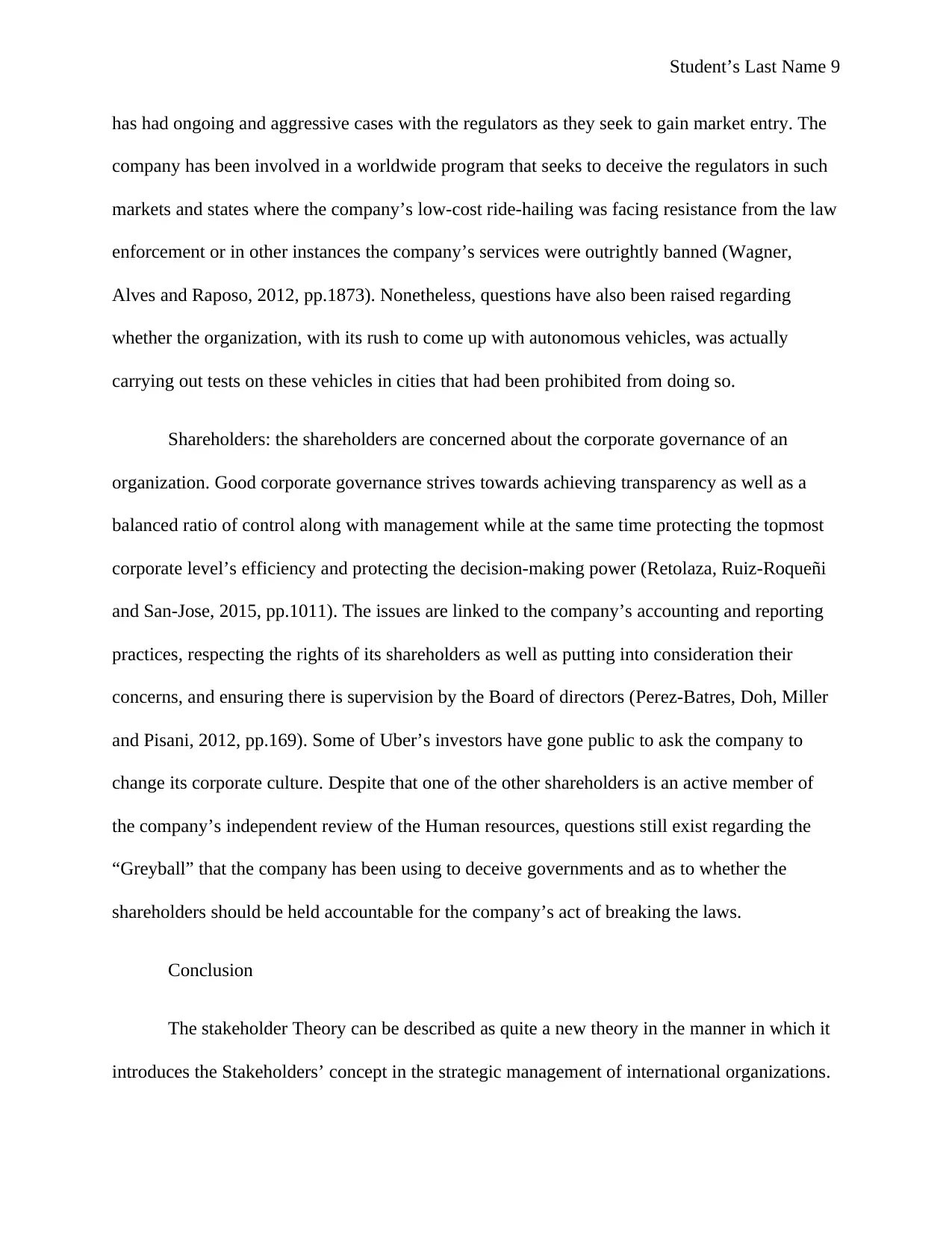
Student’s Last Name 9
has had ongoing and aggressive cases with the regulators as they seek to gain market entry. The
company has been involved in a worldwide program that seeks to deceive the regulators in such
markets and states where the company’s low-cost ride-hailing was facing resistance from the law
enforcement or in other instances the company’s services were outrightly banned (Wagner,
Alves and Raposo, 2012, pp.1873). Nonetheless, questions have also been raised regarding
whether the organization, with its rush to come up with autonomous vehicles, was actually
carrying out tests on these vehicles in cities that had been prohibited from doing so.
Shareholders: the shareholders are concerned about the corporate governance of an
organization. Good corporate governance strives towards achieving transparency as well as a
balanced ratio of control along with management while at the same time protecting the topmost
corporate level’s efficiency and protecting the decision-making power (Retolaza, Ruiz-Roqueñi
and San-Jose, 2015, pp.1011). The issues are linked to the company’s accounting and reporting
practices, respecting the rights of its shareholders as well as putting into consideration their
concerns, and ensuring there is supervision by the Board of directors (Perez-Batres, Doh, Miller
and Pisani, 2012, pp.169). Some of Uber’s investors have gone public to ask the company to
change its corporate culture. Despite that one of the other shareholders is an active member of
the company’s independent review of the Human resources, questions still exist regarding the
“Greyball” that the company has been using to deceive governments and as to whether the
shareholders should be held accountable for the company’s act of breaking the laws.
Conclusion
The stakeholder Theory can be described as quite a new theory in the manner in which it
introduces the Stakeholders’ concept in the strategic management of international organizations.
has had ongoing and aggressive cases with the regulators as they seek to gain market entry. The
company has been involved in a worldwide program that seeks to deceive the regulators in such
markets and states where the company’s low-cost ride-hailing was facing resistance from the law
enforcement or in other instances the company’s services were outrightly banned (Wagner,
Alves and Raposo, 2012, pp.1873). Nonetheless, questions have also been raised regarding
whether the organization, with its rush to come up with autonomous vehicles, was actually
carrying out tests on these vehicles in cities that had been prohibited from doing so.
Shareholders: the shareholders are concerned about the corporate governance of an
organization. Good corporate governance strives towards achieving transparency as well as a
balanced ratio of control along with management while at the same time protecting the topmost
corporate level’s efficiency and protecting the decision-making power (Retolaza, Ruiz-Roqueñi
and San-Jose, 2015, pp.1011). The issues are linked to the company’s accounting and reporting
practices, respecting the rights of its shareholders as well as putting into consideration their
concerns, and ensuring there is supervision by the Board of directors (Perez-Batres, Doh, Miller
and Pisani, 2012, pp.169). Some of Uber’s investors have gone public to ask the company to
change its corporate culture. Despite that one of the other shareholders is an active member of
the company’s independent review of the Human resources, questions still exist regarding the
“Greyball” that the company has been using to deceive governments and as to whether the
shareholders should be held accountable for the company’s act of breaking the laws.
Conclusion
The stakeholder Theory can be described as quite a new theory in the manner in which it
introduces the Stakeholders’ concept in the strategic management of international organizations.
⊘ This is a preview!⊘
Do you want full access?
Subscribe today to unlock all pages.

Trusted by 1+ million students worldwide
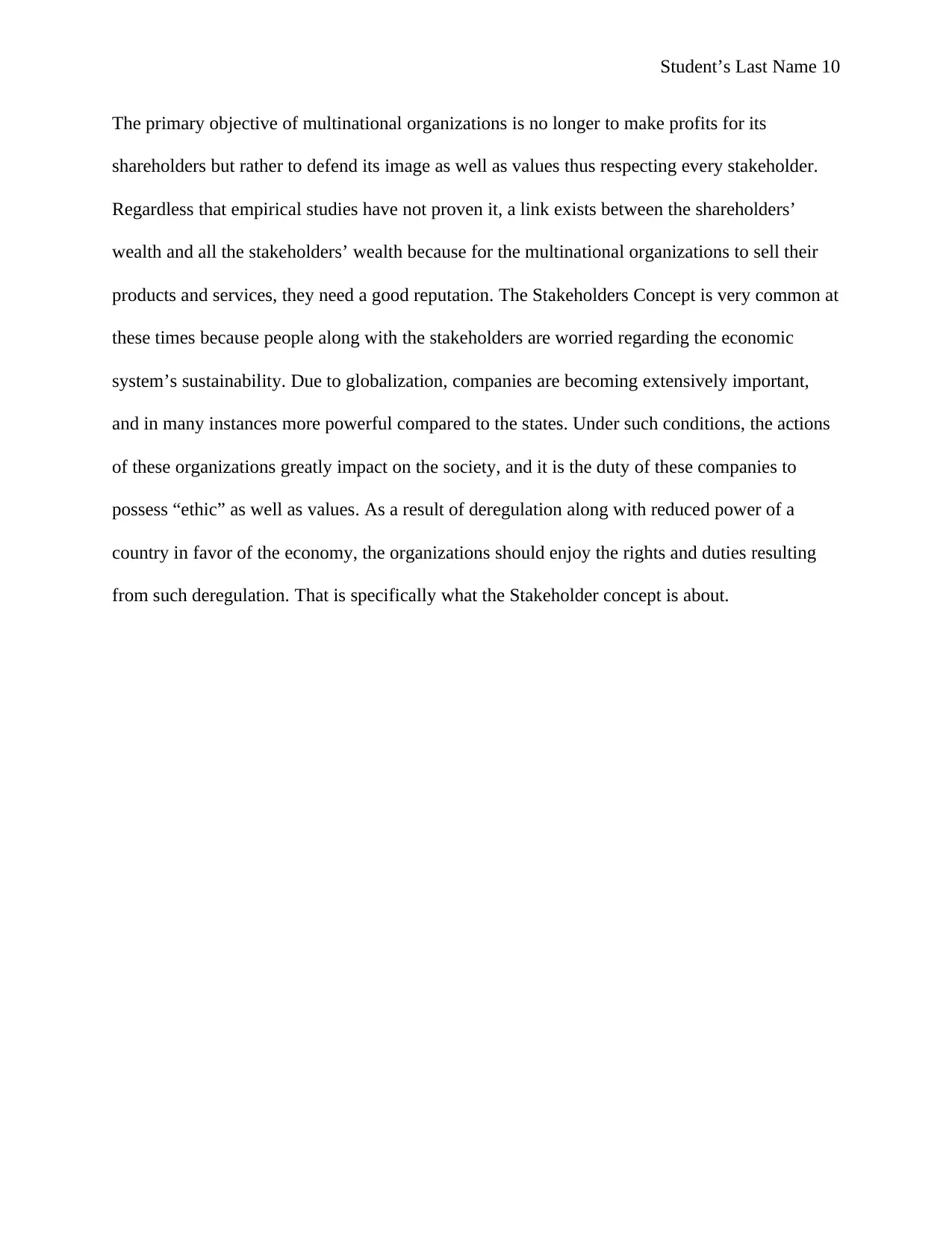
Student’s Last Name 10
The primary objective of multinational organizations is no longer to make profits for its
shareholders but rather to defend its image as well as values thus respecting every stakeholder.
Regardless that empirical studies have not proven it, a link exists between the shareholders’
wealth and all the stakeholders’ wealth because for the multinational organizations to sell their
products and services, they need a good reputation. The Stakeholders Concept is very common at
these times because people along with the stakeholders are worried regarding the economic
system’s sustainability. Due to globalization, companies are becoming extensively important,
and in many instances more powerful compared to the states. Under such conditions, the actions
of these organizations greatly impact on the society, and it is the duty of these companies to
possess “ethic” as well as values. As a result of deregulation along with reduced power of a
country in favor of the economy, the organizations should enjoy the rights and duties resulting
from such deregulation. That is specifically what the Stakeholder concept is about.
The primary objective of multinational organizations is no longer to make profits for its
shareholders but rather to defend its image as well as values thus respecting every stakeholder.
Regardless that empirical studies have not proven it, a link exists between the shareholders’
wealth and all the stakeholders’ wealth because for the multinational organizations to sell their
products and services, they need a good reputation. The Stakeholders Concept is very common at
these times because people along with the stakeholders are worried regarding the economic
system’s sustainability. Due to globalization, companies are becoming extensively important,
and in many instances more powerful compared to the states. Under such conditions, the actions
of these organizations greatly impact on the society, and it is the duty of these companies to
possess “ethic” as well as values. As a result of deregulation along with reduced power of a
country in favor of the economy, the organizations should enjoy the rights and duties resulting
from such deregulation. That is specifically what the Stakeholder concept is about.
Paraphrase This Document
Need a fresh take? Get an instant paraphrase of this document with our AI Paraphraser

Student’s Last Name 11
Bibliography
Bridoux, F. and Stoelhorst, J.W., 2014. Microfoundations for stakeholder theory: Managing
stakeholders with heterogeneous motives. Strategic management journal, 35(1), pp.107-125.
Brown, J.A. and Forster, W.R., 2013. CSR and stakeholder theory: A tale of Adam
Smith. Journal of business ethics, 112(2), pp.301-312.
Esmail, L., Moore, E. and Rein, A., 2015. Evaluating patient and stakeholder engagement in
research: moving from theory to practice. Journal of comparative effectiveness research, 4(2),
pp.133-145.
Fernando, S. and Lawrence, S., 2014. A theoretical framework for CSR practices: integrating
legitimacy theory, stakeholder theory and institutional theory. Journal of Theoretical Accounting
Research, 10(1), pp.149-178.
Ferrero, I., Michael Hoffman, W. and McNulty, R.E., 2014. Must Milton Friedman embrace
stakeholder theory?. Business and Society Review, 119(1), pp.37-59.
Freeman, E. and Moutchnik, A., 2013. Stakeholder management and CSR: questions and
answers. uwf UmweltWirtschaftsForum, 21(1-2), pp.5-9.
Harrison, J.S. and Wicks, A.C., 2013. Stakeholder theory, value, and firm performance. Business
ethics quarterly, 23(1), pp.97-124.
Harrison, J.S., Freeman, R.E. and Abreu, M.C.S.D., 2015. Stakeholder theory as an ethical
approach to effective management: Applying the theory to multiple contexts. Revista brasileira
de gestão de negócios, 17(55), pp.858-869.
Bibliography
Bridoux, F. and Stoelhorst, J.W., 2014. Microfoundations for stakeholder theory: Managing
stakeholders with heterogeneous motives. Strategic management journal, 35(1), pp.107-125.
Brown, J.A. and Forster, W.R., 2013. CSR and stakeholder theory: A tale of Adam
Smith. Journal of business ethics, 112(2), pp.301-312.
Esmail, L., Moore, E. and Rein, A., 2015. Evaluating patient and stakeholder engagement in
research: moving from theory to practice. Journal of comparative effectiveness research, 4(2),
pp.133-145.
Fernando, S. and Lawrence, S., 2014. A theoretical framework for CSR practices: integrating
legitimacy theory, stakeholder theory and institutional theory. Journal of Theoretical Accounting
Research, 10(1), pp.149-178.
Ferrero, I., Michael Hoffman, W. and McNulty, R.E., 2014. Must Milton Friedman embrace
stakeholder theory?. Business and Society Review, 119(1), pp.37-59.
Freeman, E. and Moutchnik, A., 2013. Stakeholder management and CSR: questions and
answers. uwf UmweltWirtschaftsForum, 21(1-2), pp.5-9.
Harrison, J.S. and Wicks, A.C., 2013. Stakeholder theory, value, and firm performance. Business
ethics quarterly, 23(1), pp.97-124.
Harrison, J.S., Freeman, R.E. and Abreu, M.C.S.D., 2015. Stakeholder theory as an ethical
approach to effective management: Applying the theory to multiple contexts. Revista brasileira
de gestão de negócios, 17(55), pp.858-869.
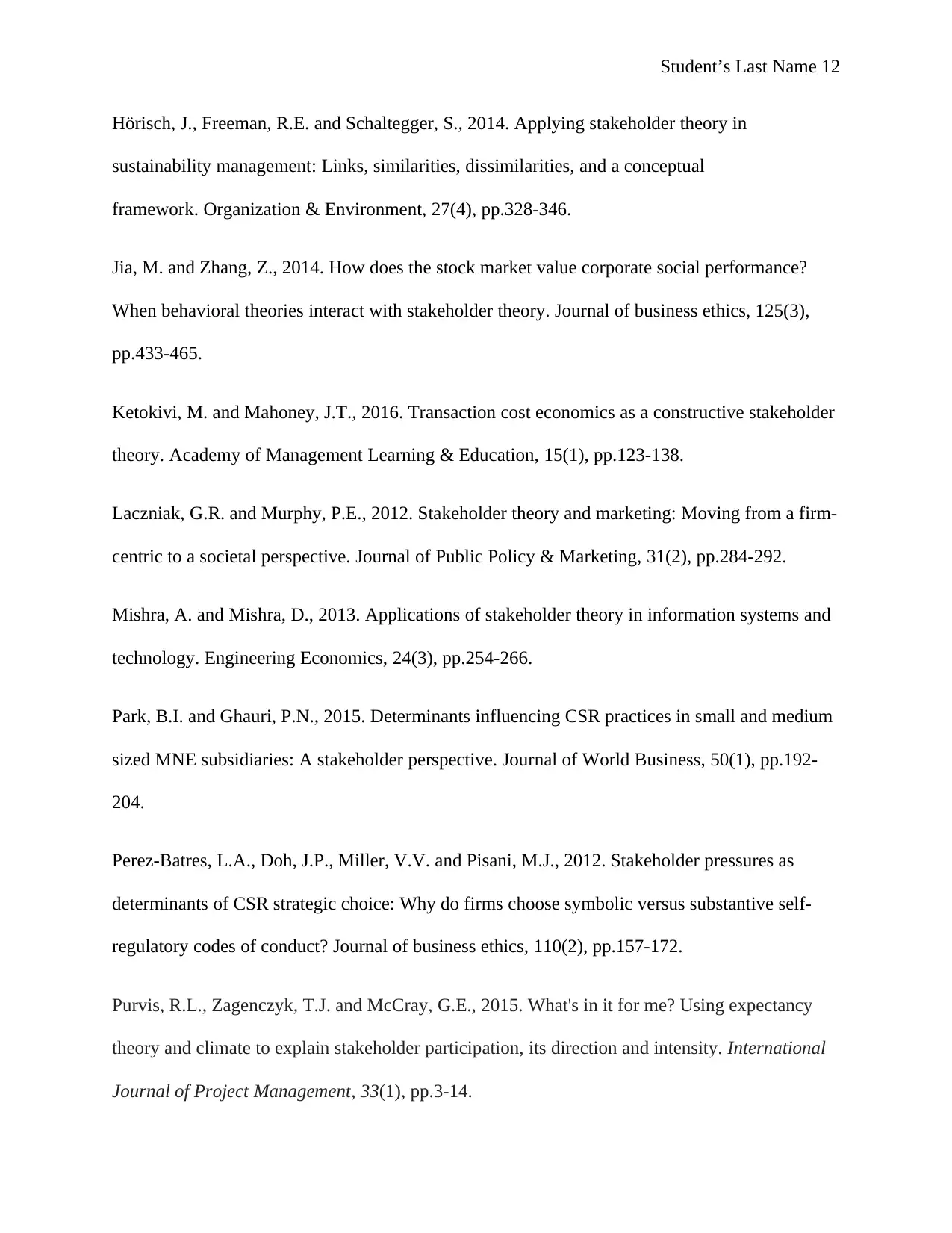
Student’s Last Name 12
Hörisch, J., Freeman, R.E. and Schaltegger, S., 2014. Applying stakeholder theory in
sustainability management: Links, similarities, dissimilarities, and a conceptual
framework. Organization & Environment, 27(4), pp.328-346.
Jia, M. and Zhang, Z., 2014. How does the stock market value corporate social performance?
When behavioral theories interact with stakeholder theory. Journal of business ethics, 125(3),
pp.433-465.
Ketokivi, M. and Mahoney, J.T., 2016. Transaction cost economics as a constructive stakeholder
theory. Academy of Management Learning & Education, 15(1), pp.123-138.
Laczniak, G.R. and Murphy, P.E., 2012. Stakeholder theory and marketing: Moving from a firm-
centric to a societal perspective. Journal of Public Policy & Marketing, 31(2), pp.284-292.
Mishra, A. and Mishra, D., 2013. Applications of stakeholder theory in information systems and
technology. Engineering Economics, 24(3), pp.254-266.
Park, B.I. and Ghauri, P.N., 2015. Determinants influencing CSR practices in small and medium
sized MNE subsidiaries: A stakeholder perspective. Journal of World Business, 50(1), pp.192-
204.
Perez-Batres, L.A., Doh, J.P., Miller, V.V. and Pisani, M.J., 2012. Stakeholder pressures as
determinants of CSR strategic choice: Why do firms choose symbolic versus substantive self-
regulatory codes of conduct? Journal of business ethics, 110(2), pp.157-172.
Purvis, R.L., Zagenczyk, T.J. and McCray, G.E., 2015. What's in it for me? Using expectancy
theory and climate to explain stakeholder participation, its direction and intensity. International
Journal of Project Management, 33(1), pp.3-14.
Hörisch, J., Freeman, R.E. and Schaltegger, S., 2014. Applying stakeholder theory in
sustainability management: Links, similarities, dissimilarities, and a conceptual
framework. Organization & Environment, 27(4), pp.328-346.
Jia, M. and Zhang, Z., 2014. How does the stock market value corporate social performance?
When behavioral theories interact with stakeholder theory. Journal of business ethics, 125(3),
pp.433-465.
Ketokivi, M. and Mahoney, J.T., 2016. Transaction cost economics as a constructive stakeholder
theory. Academy of Management Learning & Education, 15(1), pp.123-138.
Laczniak, G.R. and Murphy, P.E., 2012. Stakeholder theory and marketing: Moving from a firm-
centric to a societal perspective. Journal of Public Policy & Marketing, 31(2), pp.284-292.
Mishra, A. and Mishra, D., 2013. Applications of stakeholder theory in information systems and
technology. Engineering Economics, 24(3), pp.254-266.
Park, B.I. and Ghauri, P.N., 2015. Determinants influencing CSR practices in small and medium
sized MNE subsidiaries: A stakeholder perspective. Journal of World Business, 50(1), pp.192-
204.
Perez-Batres, L.A., Doh, J.P., Miller, V.V. and Pisani, M.J., 2012. Stakeholder pressures as
determinants of CSR strategic choice: Why do firms choose symbolic versus substantive self-
regulatory codes of conduct? Journal of business ethics, 110(2), pp.157-172.
Purvis, R.L., Zagenczyk, T.J. and McCray, G.E., 2015. What's in it for me? Using expectancy
theory and climate to explain stakeholder participation, its direction and intensity. International
Journal of Project Management, 33(1), pp.3-14.
⊘ This is a preview!⊘
Do you want full access?
Subscribe today to unlock all pages.

Trusted by 1+ million students worldwide
1 out of 13
Your All-in-One AI-Powered Toolkit for Academic Success.
+13062052269
info@desklib.com
Available 24*7 on WhatsApp / Email
![[object Object]](/_next/static/media/star-bottom.7253800d.svg)
Unlock your academic potential
Copyright © 2020–2025 A2Z Services. All Rights Reserved. Developed and managed by ZUCOL.
